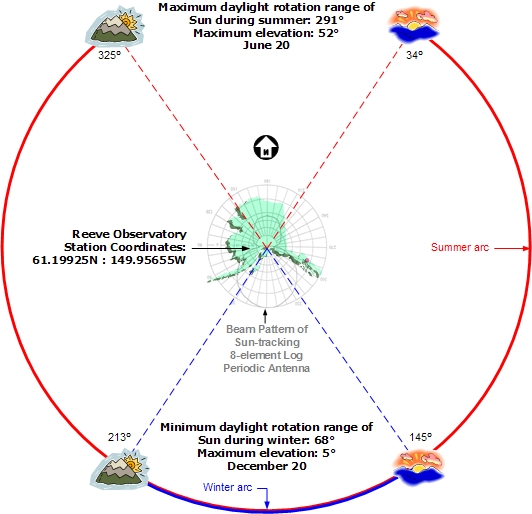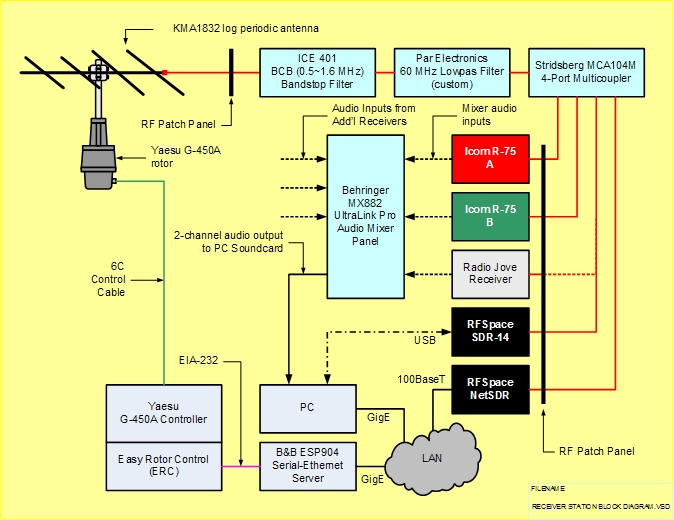Solar Radio Emissions at HF (go direct to HF Solar Radio) and VHF/UHF (go direct to e-CALLISTO)
We started monitoring solar activity in May 2009 not long after the end of sunspot cycle 23 (fall 2008). We presently operate three systems for monitoring solar emissions, all in the HF frequency band, located at Anchorage, Cohoe and Gakona (HAARP), Alaska.
Solar radio emissions generally are associated with solar active regions and related to flare activity. Many solar radio emission have similar characteristics and are classified on the basis of their frequency and time (spectral and temporal) characteristics into seven types, Type I through Type VII with Types I through Type V being basic types and Types VI and VII being extensions of Type III and Type V. See table below for a summary of spectral classifications.
Solar Radio Burst Spectral Classifications ~ General (see also table notes below)
|
Type |
Characteristics |
Duration |
Frequency Range (MHz) |
Associated Phenomena |
|
I |
Short, narrow-bandwidth bursts. Usually occur in large numbers with underlying continuum |
Single: ~1 second |
80 – 200 |
Active regions, flares, |
|
II |
Slow frequency drift bursts. Usually accompanied by a second harmonic |
3 – 30 minutes |
Fundamental: |
Flares, proton emission, magneto-hydrodynamic shockwaves |
|
III |
Fast frequency drift bursts. Can occur singularly, in groups, or storms often with underlying continuum. Can be accompanied by a second harmonic |
Single: 1 – 3 seconds |
0.01 – 1000 |
Active regions, flares |
|
IV |
Stationary Type IV: |
Hours – days |
20 – 2000 |
Flares, proton emission |
|
Moving Type IV: |
0.5 – 2 hours |
20 – 400 |
Eruptive prominences, |
|
|
Flare Continua: |
3 – 45 minutes |
10 – 200 |
Flares, proton emission |
|
|
V |
Smooth, short-lived continuum. Follows some type III bursts. Never occurs in isolation |
1 – 3 minutes |
10 – 200 |
Same as type III bursts |
|
VI |
Series of Type III bursts over a period of 10 minutes or more, with no period longer than 30 minutes without activity |
> 10 minutes |
See Type III |
See Type III |
|
VII |
Series of Type III and Type V bursts over a period of 10 minutes or more, with no period longer than 30 minutes without activity |
> 10 minutes |
See Type III and Type V |
See Type III |
Table notes:
1. Drifting bursts almost always drift from high to low frequencies
2. Frequency range is the typical range in which the bursts appear and not
their bandwidth
3. Sub-types of Type IV are not universally agreed upon
Solar Radio Bursts ~ Summary of Major Characteristics
(source: Table 1, Radio emission from the sun and stars, Dulk, 1985, http://adsabs.harvard.edu/abs/1985ARA&A..23..169D )
|
Burst type |
Duration at |
Temperature (K) |
Polarization (circular) |
Frequency range/ bandwidth |
Height range/ magnetic topology |
Association |
Emission mechanism |
|
I |
≤ 1 s |
≥ 1010 |
50 – 100% |
50-300 MHz/ ~1 MHz (burst)
|
0.1 – 0.6 R0/ closed |
large sunspots |
fundamental plasma |
|
I storm |
days to weeks |
≥ 1010 |
o-mode |
~100 MHz (storm) |
|
|
|
|
III storm |
days to weeks |
≥ 1010 |
o-mode |
50 MHz – 30 kHz/ |
0.6 R0 – 1 AU/ open |
Type I storms |
fundamental and/or harmonic plasma |
|
II |
≥ 10 min |
108 – 1011 |
usually unpolarized |
200 → 1 MHz/ 10 MHz |
0.2 – 200 R0/ open |
flare shockwave |
fundamental and harmonic plasma |
|
III |
few seconds |
108 – 1012
(to 1013 at |
fundamental: 30% harmonic: 10% o-mode |
200 → 1 MHz/ 10 MHz 2 harmonics |
0.2 – 200 R0/
open (closed for |
c/3 electron stream |
fundamental and harmonic plasma |
|
IV moving |
~ 30 min |
108 – 109 |
low → high x-mode |
200 → 10 MHz/ > 10 MHz |
0.5 - few R0 / plasmoid |
small flare |
gyrosynchronous and/or plasma |
|
IV flare continuum |
~ 20 min |
108 – 1012 |
0 – 40% o-mode ? |
200 → 10 MHz/ 100 MHz |
0.1 – 1 R0/ closed ? |
moderate to large flare, initial phase |
plasma ? |
|
IV storm continuum |
few hours |
> 108 |
60 – 100% o-mode |
50 – 300 MHz/ 100 MHz |
0.1 – 0.6 R0/ closed ? |
flare, late phase |
fundamental plasma |
|
V |
> 1 min |
108 – 1011 |
< 10% x-mode |
100 → 10 MHz/ 50 MHz |
0.5 – 2 R0/ open ? |
follows some Type IIIs |
harmonic plasma |
|
Microwave impulse |
> 1 min (at 10 GHz) |
107 – 109 |
~ 30% x-mode |
3 – 30 GHz/ 10 GHz |
~ 104 km closed |
small to large flares hard x-rays |
gyrosynchronous (Maxwellian or power law) |
|
microwave IV |
~ 10 min |
107 – 109 |
~ 10% x-mode |
1 – 30 GHz/ 5 GHz |
104 – 105 km closed |
large flares with shocks |
gyrosynchronous (power law) |
|
microwave postburst |
minutes to hours |
~ 107 |
low |
1 – 10 GHz/ 5 GHz |
104 – 105 km closed |
flare, late phase |
thermal bremsstrahlung |
|
microwave spike burst |
~ 10 ms (burst) ~ 10 min (group) |
> 1013 |
~ 100% x-mode ? |
~ 0.5 – 5 GHz/ few MHz |
104 – 105 km closed |
flare, hard x-rays |
cyclotron maser |
Solar Radio Bursts ~ Frequency-Time Characteristics
(source: Figure 11, Radio emission from the sun and stars, Dulk, 1985, http://adsabs.harvard.edu/abs/1985ARA&A..23..169D )

Seasonal Variations in Solar Radio Observations at Anchorage, Alaska USA
The diagram immediately below shows how
the geometry of our observations varies from summer to winter.

High-frequency system operating in the approximate range of 3~30 MHz (primarily 15~32 MHz) called the HF System.
Click here for information and data for our HF System.
A block diagram is shown below.

Solar spectrometer operating in the range of 45~870 MHz called the e-CALLISTO system.
Click here to view information and data for our e-CALLISTO System.
We participate in the e-CALLISTO solar spectrometer network sponsored by the Swiss Institute of Technology, ETH Zurich. A block diagram is shown below.
